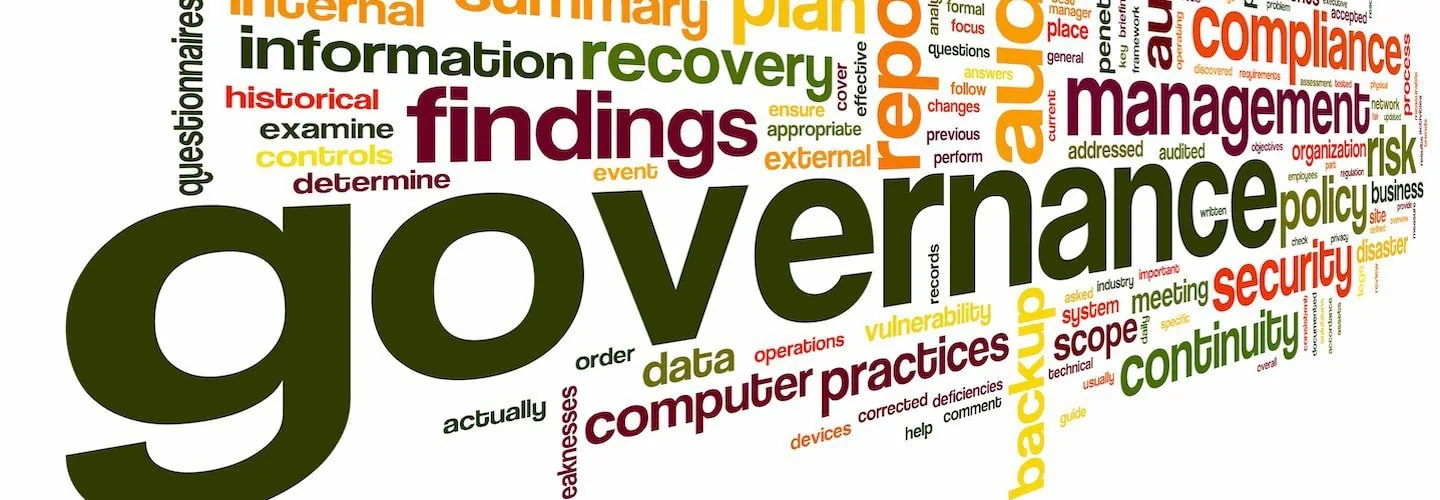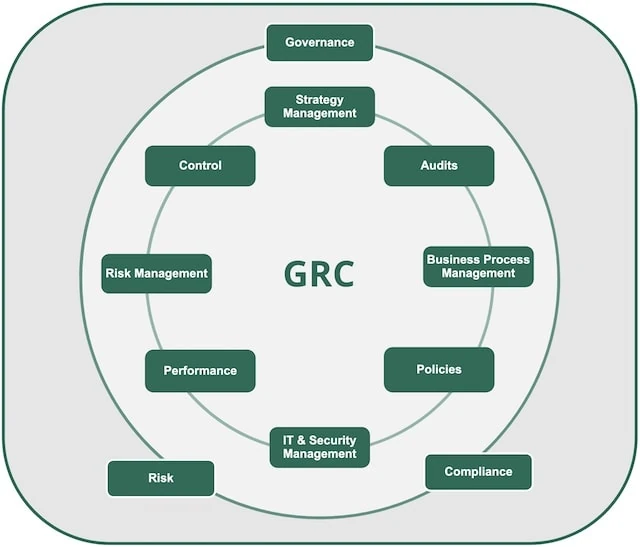

What is GRC?
GRC describes the integration of internal organizational practices covering the following topics: governance, risk management and compliance. This collection of capabilities enables enable an organization or company to reliably achieve goals, as well as deal with uncertainties and risks. Furthermore, it aims to ensure integrity in all actions.
GRC as a discipline synchronizes governance, risk management and compliance activities to ensure efficiency at work and information sharing across business units. This helps to prevent silos that operate independently and without coordination.
Particularly in larger organizations, companies or critical infrastructures (see also EPCIP/ CIP), interdisciplinary exchange is essential to avoid GRC task creep. The tasks are required by the business units in order to save costs, minimize risks and generate GRC reports on demand.
Since Governance, Risk & Compliance should cover all areas of the company, IT is increasingly called upon in the course of the digital transformation and must be included in all considerations.
Which business areas does governance, risk & compliance affect?
GRC should be applied throughout the company. The following areas are particularly noteworthy:
- Board of Directors
- Corporate Management
- Auditing
- Compliance
- Risk Management
- Legal
- Finance
- Human Resources
- IT
The Governance, Risk Management & Compliance Framework
For the implementation of GRC, a framework is needed that enables the company to pursue its goals, but also to manage risks and comply with legal requirements. In order for this framework to be applied in all areas of a company, an integrated solution is needed that prevents silos or individual solutions within a company. Only centralized management ensures company-wide implementation and control of policies and objectives.
The functionalities of an integrated GRC solution should enable the company’s management to plan, implement and ensure compliance with governance, risk and compliance policies in accordance with ethical principles.
This includes:
- Risk Management
- Risk Analysis
- Risk Assessment
- Problem Management
- Policy Management
- Change Management
- Process Management
- Business Continuity Management and Information Management
- Assessment and audit functions
- Reporting
- Documentation and communication functions

What is meant by Governance?
Governance is the combination of defined processes that are executed by the company’s management (or board of directors). Governance decides how a company is set up structurally and administratively in order to achieve the set goals.
IT Governance
The digital transformation in companies today makes it essential that governance is also practiced in IT. IT governance ensures that a company’s goals are also structurally supported by IT. Processes, security and compliance must be taken into account and implemented. As with the other areas of governance, responsibility lies with the board and management.
What is meant by risk management?
Risk management is the prediction and management of risks that could prevent the organization from reliably achieving its objectives or even endanger the organization/company.
IT Risk Management
IT risk management monitors, evaluates and identifies risks and threats that jeopardize the achievement of corporate objectives at an early stage. Security incident management uses processes and rules of conduct to determine how to react adequately in the event of an incident. Incident management software helps to react as quickly as possible and in an audit-proof manner with predefined processes and responsibilities.
What is meant by Compliance?
Compliance oversees the observance of prescribed limits (laws and regulations. For example, GDPR for IT compliance) and voluntary limits in organizations (internal guidelines and rules of conduct.) Compliance represents a clearly defined set of rules that covers all areas of a business organization and must be observed accordingly throughout the entire company.
Compliance is more than just following regulations. Compliance is about mindset and culture throughout the company. It questions actions and is the basis for an awareness that enables us to make ethical and responsible decisions.Bernd Maus
Compliance Rules
- Corporate guidelines (Code of Conduct)
- Finance
- Legal (Law & Justice)
- Equality
- Safety, health and environmental protection
- IT usage and infrastructure
- Privacy and data protection
- Audit
IT Compliance
IT compliance oversees the observance of legal, internal organizational and contractual regulations in the area of IT. The requirements assigned to IT compliance include the following IT information security areas: IT security, availability, data retention, and data protection.
How can GRC software help?
Companies are exposed to a variety of risks and uncertainties. A lack of interface between the individual business units and working solely with e-mail, Word documents or Excel sheets make it difficult to work in a coordinated and efficient manner to avoid risks and identify opportunities.
GRC software (Governance Risk Compliance Software) helps to make the workflow efficient by automating business processes.
Responsibilities and workflows are specified by the processes. Information is recorded uniformly with the help of forms.
Information is no longer decentralized in individual departments, but is processed centrally. This creates transparency in the company and prevents duplication of work. The standardized and centralized collection of governance, risk and compliance data simplifies evaluation and control and prevents errors. This enables management to make decisions based on up-to-date data.
.
GRC and ISMS
An ISMS (Information Security Management System) is integrated into the GRC concept. An information security management system is an essential component for assessing risks based on current data in GRC-driven management, enabling decision-making and providing information as needed. A powerful ISMS software solution according to ISO/IEC 27001 supports you in organizing and controlling risk and compliance management.
GRC and IT security solutions
In IT security, data protection, data retention and information security, among other things, are defined and required by regulations. However, successful implementation requires measures that ensure compliance with and also control of the regulations. IT security solutions help support this need.
IT risks have a direct impact on business risk. It is not uncommon for a failure of the IT infrastructure to also mean a complete outage or at least restricted business activity with loss of revenue. Failure to comply with data protection guidelines can result in a hefty fine and, even worse, damage to the company’s reputation. The above-mentioned risks therefore show very clearly how important risk management and compliance are in IT today. Establishing appropriate solutions is an absolute must.
Learn how OTRS can support your company in managing Governance, Risk & Compliance.
Categories
- About OTRS Group (21)
- Automation (3)
- Corporate Security (26)
- Customer Service (31)
- Developing a Corporate Culture (12)
- Digital Transformation (53)
- General (79)
- ITSM (31)
- Leadership (22)
- OTRS in Action (8)
- Processes (5)
- Using OTRS (14)
